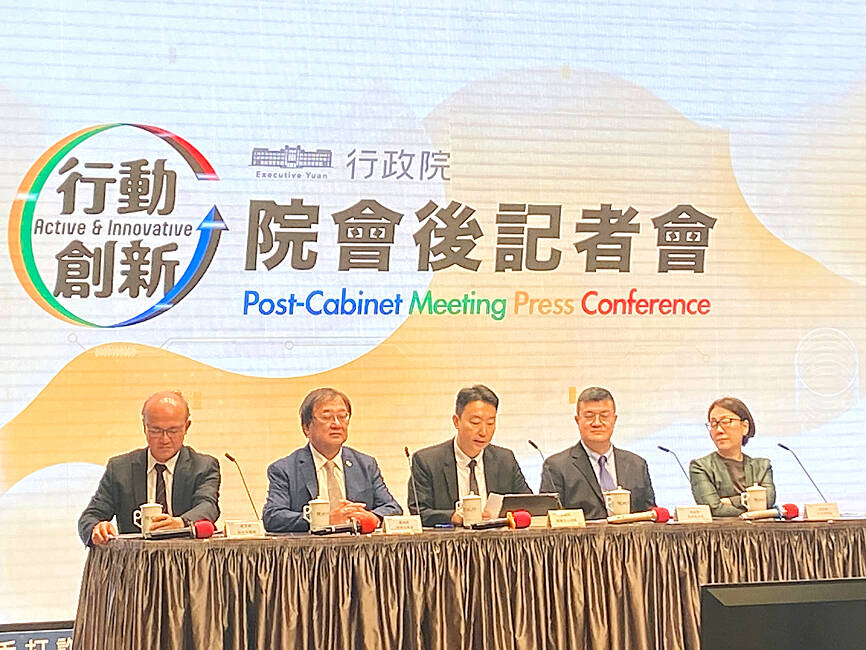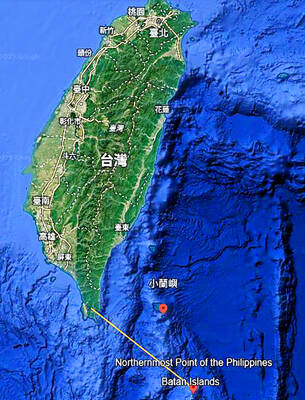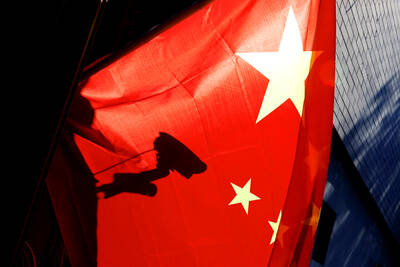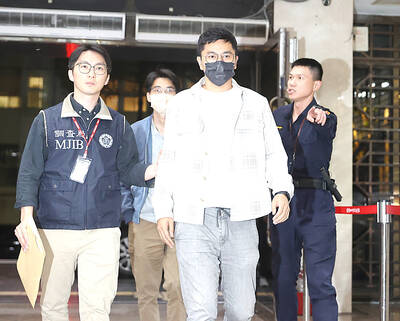The Cabinet yesterday passed a proposal to fund new cancer medicines and would allocate NT$5 billion (US$153.82 million) from next year’s budget to the program.
As cancer has long been the leading cause of death in Taiwan, the Cabinet approved the proposal from the Ministry of Health and Welfare to “raise the accessibility of new cancer medicines” in line with the national cancer control program.
The plan is part of President William Lai’s (賴清德) “Healthy Taiwan” policy, with the aim of reducing cancer deaths by one-third by 2030.

Photo: Chung Li-hua, Taipei Times
To meet the medicinal needs of people with cancer, the ministry would set up a national institute to assess health technology — which would be a non-departmental public body — launch a parallel review system and establish a fund for new cancer drugs, National Health Insurance Administration (NHIA) Director-General Shih Chung-liang (石崇良) told a news conference after the Cabinet meeting.
The Executive Yuan would allocate NT$5 billion from the official budget to the National Health Insurance fund as a fund for temporary new cancer drugs, which is expected to eventually reach and remain at NT$10 billion, Minister of Health and Welfare Chiu Tai-yuan (邱泰源) said.
While some of the funds would be allocated to the NHI fund in the short term, amendments to the Cancer Control Act (癌症防治法) would be formulated to stabilize financial sources of the new medicines fund in the medium and long term, Shih said.
The budget would be the main source of funding, which is projected to reach NT$10 billion within three years, he said, adding that medicine reviews, financial controls, eligibility evaluations and information openness would be established to ensure the program’s effectiveness.
Executive Yuan spokesman Chen Shi-kai (陳世凱) quoted Premier Cho Jung-tai (卓榮泰) as saying that the ministry should accelerate the fund’s establishment to ensure stable payments for new medicines, as well as safeguard the right of the public to medicine.
Meanwhile, the budget for cancer screening programs would receive a NT$4 billion boost to NT$6.8 billion next year, while eligibility would be expanded for government-funded screenings for cervical, colorectal, breast, lung and gastric cancers, Shih said, adding that screening subsidy rules would be changed.
Eligibility would be expanded to offer government-funded lung cancer screenings for people who smoke at least 20 packs of cigarettes per year or have a family history of lung cancer, the NHIA said.
Other expanded eligibility conditions include: breast cancer screenings for women aged 40 to 74, up from 45 to 70 previously; cervical cancer screenings for women from age 25, down from 29; colorectal cancer screenings from age 45, down from 49, or from 40, down from 44 for those with a family history of the disease; HPV testing at age 35, 45 and 65; Helicobacter pylori stool antigen testing for people aged 45 to 74; and continued enhancement of cancer screenings and follow-up checks for positive cases, it said.
To achieve the goal of a “Healthy Taiwan,” the ministry should enhance its development and implementation of public health policies that incorporate exercise and nutrition management, Chen quoted Cho as saying, adding that the application of artificial intelligence should be considered to increase precision and efficiency.

‘FORM OF PROTEST’: The German Institute Taipei said it was ‘shocked’ to see Nazi symbolism used in connection with political aims as it condemned the incident Sung Chien-liang (宋建樑), who led efforts to recall Democratic Progressive Party (DPP) Legislator Lee Kun-cheng (李坤城), was released on bail of NT$80,000 yesterday amid an outcry over a Nazi armband he wore to questioning the night before. Sung arrived at the New Taipei City District Prosecutors’ Office for questioning in a recall petition forgery case on Tuesday night wearing a red armband bearing a swastika, carrying a copy of Adolf Hitler’s Mein Kampf and giving a Nazi salute. Sung left the building at 1:15am without the armband and apparently covering the book with a coat. This is a serious international scandal and Chinese

A US Marine Corps regiment equipped with Naval Strike Missiles (NSM) is set to participate in the upcoming Balikatan 25 exercise in the Luzon Strait, marking the system’s first-ever deployment in the Philippines. US and Philippine officials have separately confirmed that the Navy Marine Expeditionary Ship Interdiction System (NMESIS) — the mobile launch platform for the Naval Strike Missile — would take part in the joint exercise. The missiles are being deployed to “a strategic first island chain chokepoint” in the waters between Taiwan proper and the Philippines, US-based Naval News reported. “The Luzon Strait and Bashi Channel represent a critical access

COUNTERINTELLIGENCE TRAINING: The ministry said 87.5 percent of the apprehended Chinese agents were reported by service members they tried to lure into becoming spies Taiwanese organized crime, illegal money lenders, temples and civic groups are complicit in Beijing’s infiltration of the armed forces, the Ministry of National Defense (MND) said in a report yesterday. Retired service members who had been turned to Beijing’s cause mainly relied on those channels to infiltrate the Taiwanese military, according to the report to be submitted to lawmakers ahead of tomorrow’s hearing on Chinese espionage in the military. Chinese intelligence typically used blackmail, Internet-based communications, bribery or debts to loan sharks to leverage active service personnel to do its bidding, it said. China’s main goals are to collect intelligence, and develop a

PERSONAL DATA: The implicated KMT members allegedly compiled their petitions by copying names from party lists without the consent of the people concerned Judicial authorities searched six locations yesterday and questioned six people, including one elderly Chinese Nationalist Party (KMT) member and five KMT Youth League associates, about alleged signature forgery and fraud relating to their recall efforts against two Democratic Progressive Party (DPP) legislators. After launching a probe into alleged signature forgery and related fraud in the KMT’s recall effort, prosecutors received a number of complaints, including about one petition that had 1,748 signatures of voters whose family members said they had already passed away, and also voters who said they did not approve the use of their name, Taipei Deputy Chief Prosecutor